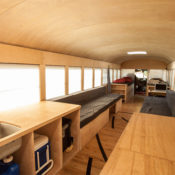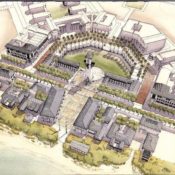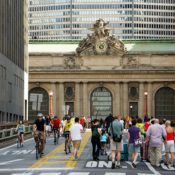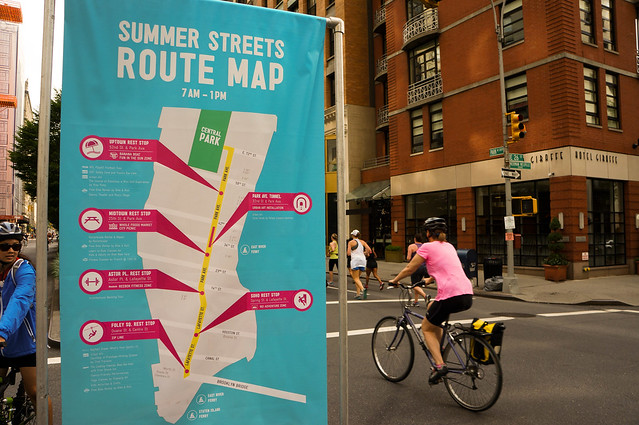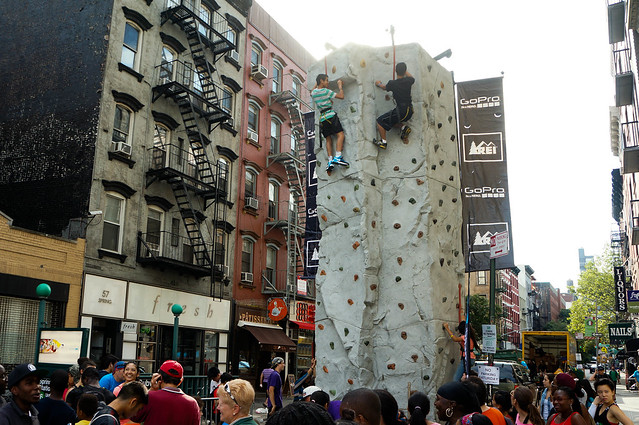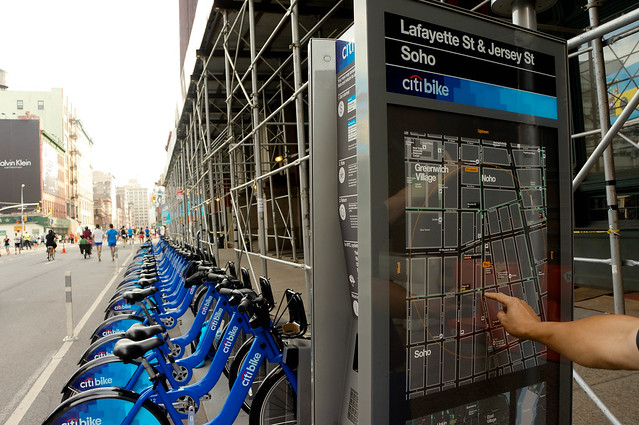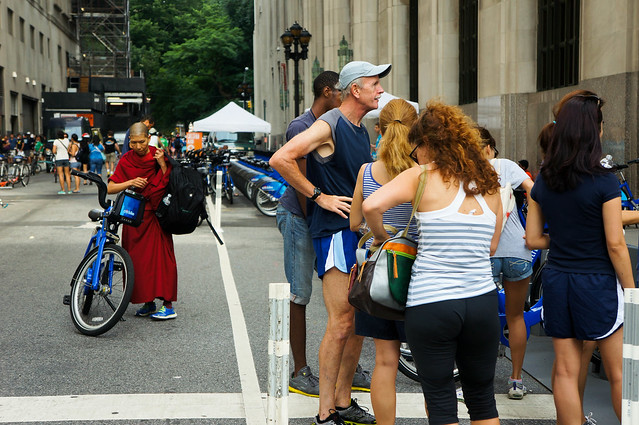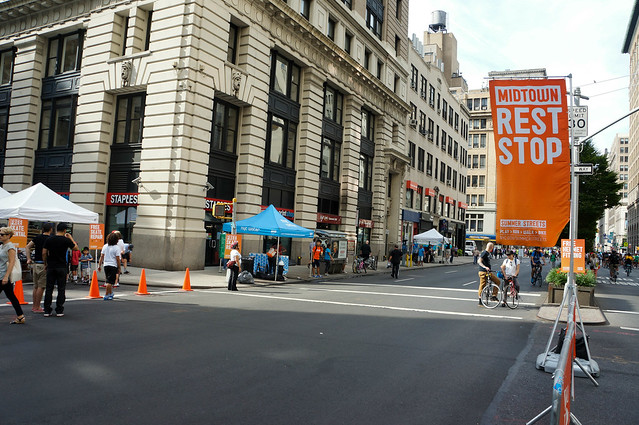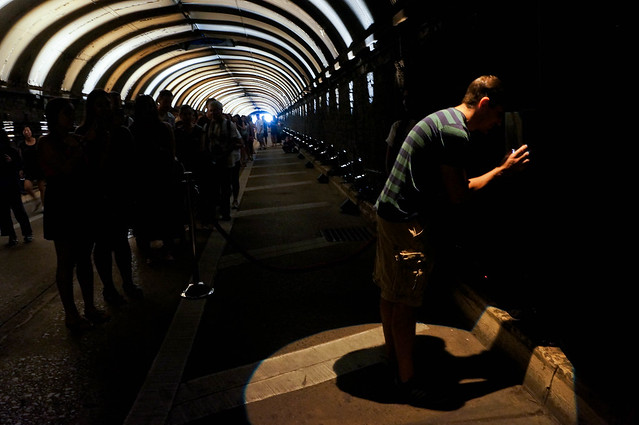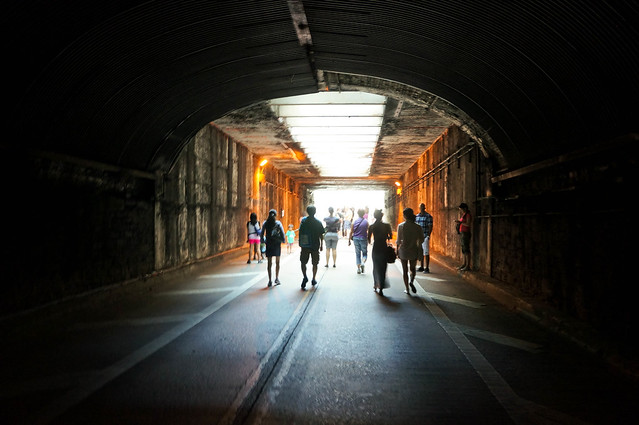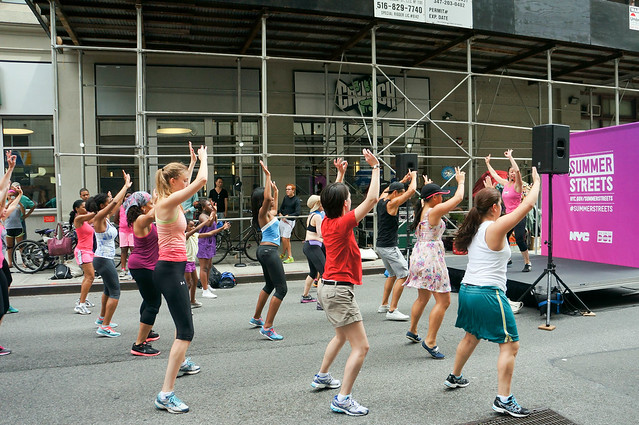Author: Lucy Wang
The Daily Blend for Friday, August 23, 2013
Mother Nature’s nasty appetite is getting even bigger. Last Friday, I shared a link about the sinkhole that swallowed parts of a resort near Disney World. Today’s environmental disaster was shot in Louisiana, where an entire stand of trees gets swallowed by an underwater sinkhole above a collapsing salt mine. (Colossal)
LANDSCAPE ARCHITECTURE
- If you’re like me, every time you see the FDR Four Freedoms Park you’re reminded of that time you intended to go but kept putting it off since it was on Roosevelt Island. Thanks to video artist Barrett Doherty, you can take a virtual tour of the park in his 10-minute video in the meantime. Jared Green also gives us some background of the park that was originally designed by architect Louis Kahn and landscape architect Harriet Pattison. (The Dirt)
- GSD Assistant Dean Stephen M. Ervin explores the burgeoning field of geodesign. (The Field)
- Thomas Rainer examines a growing trend as landscape architecture moves away from orthogonal grids and towards layered incongruity. (grounded design)
& RELATED
- This story makes me feel like I was born in the right generation. Millennials ditch the traditional “American Dream” of car and home ownership for a life that’s low on material goods, but rich with experiences (and biking!). (NPR)
- Did the staggering amount of parking in downtown Detroit play a part in the city’s downfall? (Urbanophile)
- Frank Lloyd Wright is best known for his architecture, but ‘Conversations with Artists’ reveals his rapier wit and feisty critiques on everything from his contemporaries to the NYC skyline. (Brain Pickings)
The Daily Blend is Breaking Ground on the Latest in Landscape Architecture. Have any good stories you’d like to share? Post them on Land8’s Story Board section!
The Daily Blend for Thursday, August 22, 2013
Did you know that the Mississippi River watershed is the fourth largest in the world? The National Atlas of the United States has created Streamer, an online exploration tool–it’s like Google Maps for creeks–that aims to help people learn more where their water goes. (Co.Design)
LANDSCAPE ARCHITECTURE
- A psychedelic, interactive forest of lights takes over an empty factory in Eindhoven, Netherlands. (The Dirt)
- Landscape Forms announces their partnership with Brazilian company Kojima, marking a milestone in the company’s global growth strategy. The partnership makes Brazil Landscape Forms’ first major market outside North America. (Landscape Forms)
- Is the High Line coming to Queens, NY? WXY architecture + urban design and dlandstudio were recently selected to lead the design and feasibility plan to turn 3.5 miles of an abandoned railroad into the new QueensWay park. (Trust for Public Land)
- The Graham Foundation recently awarded $448,000 in grants to 40 projects by organizations! Among them: ‘Airport Landscape: Urban Ecologies in the Aerial Age,’ an exhibit curated by the GSD landscape architecture department chair Charles Waldheim and associate landscape architecture professor Sonja Dümpelmann. It will be open October 30 to December 19. (Harvard)
& RELATED
- Speaking of Graham Foundation Grant winners, the Design Observer’s Places Journal has also been awarded a grant! The grant will fund a series of in-depth articles, “History of the Present,” that focus on urban issues. (Places)
- Urban planning takes on positive education reform through “mixed-use education,” a way of integrating educational spaces with other community uses. (Planetizen)
- Thanks to climate change, by 2050, coastal flooding could cost cities $60 billion a year… (Grist)
- And the situation won’t getting any better if China’s land use patterns don’t change. (Mother Jones)
The Daily Blend is Breaking Ground on the Latest in Landscape Architecture. Have any good stories you’d like to share? Post them on Land8’s Story Board section!
The Daily Blend for Wednesday, August 21, 2013
Recent architecture grad Hank Butitta converted an old school bus into a sleek and modern mobile home using wood recycled from an old gymnasium. And it’s gets even cooler: Hank his two buddies embarked on a 5,000 mile road trip across the U.S. on said bus. Check out their trip! (Colossal)
LANDSCAPE ARCHITECTURE
- A leaked draft report by the IPCC says that they are 95-percent certain that climate change is caused by human activity. (The Dirt)
- Donald Molnar, FASLA, writes a preview of the upcoming fourth edition to Anatomy of a Park, a series of lectures that seek to bridge the learning gap between landscape architects and park users. (The Field)
- Landscape architects are increasingly given their due as major leaders in complex urban issues. Starting with Chris Reed’s Flux City, a landscape architecture studio that focused on rising sea levels and climate change, Harvard hopes to further expand the issue into an interdisciplinary dialogue across the University. (Harvard)
& RELATED
- I’ve been raving about Pittsburgh ever since my first visit last year. I got used to the skeptical looks, but the rust belt city is increasingly winning over the hearts of many. On my dash recently: reasons why it’s a great city for biking and walking, a “best city” face-off between Pittsburgh and Portland, and how the Steel City plans to warm up winter with a great temporary arts program.
- Bruce McVean of Movement for Liveable London recommends 16 must-read city books for all us urbanophiles out there. (This Big City)
- How a road diet can lead to successful placemaking: the redesign of Main Street in Hamburg, NY into a pedestrian friendly avenue dramatically increased the quality of life and brought the town back from the brink of death. As one resident says: if you build a place for cars, it will gather cars; but build it for people, and it will gather people. (NY Times)
The Daily Blend is Breaking Ground on the Latest in Landscape Architecture. Have any good stories you’d like to share? Post them on Land8’s Story Board section!
The Daily Blend for Tuesday, August 20, 2013
Could turning crosswalks into colorful works of art entice more people to walk? (Pop Up City)
LANDSCAPE ARCHITECTURE
- The LSU Robert Reich School of Landscape Architecture welcomes two new assistant professors: Forbes Lipschitz and Richard Hindle. (LSU)
- Are you a Dan Kiley fan? If so, you’ll want to check out TCLF’s upcoming Landslide compendium, a retrospective of Kiley’s work. If you’re in Boston, you may also want to attend the opening reception in November. (The Cultural Landscape Foundation)
- Speaking of upcoming events in Boston, in about a month’s time the annual Landscape Lectures are due to kick off at the Isabella Stewart Gardner Museum and will feature speakers such as Gary Hilderbrand and Andrea Cochran. (Gardner Museum)
& RELATED
- Bryant Parks is awarded the distinction of City Parks’ Frontline Park for the month of August. (City Parks)
- The New York Times created a fascinating animated 3D rendered tour of the many ways New York’s mayor Bloomberg reshaped the urban fabric of New York. (NY Times)
- Is change by another name still gentrification? Activists in Boyle Heights, a Latino neighborhood in L.A., prefer to describe their efforts for positive change as “gentefication”–a play on the Spanish word for people–as they attempt to win over some wary residents. (Planetizen)
The Daily Blend is Breaking Ground on the Latest in Landscape Architecture. Have any good stories you’d like to share? Post them on Land8’s Story Board section!
The Daily Blend for Monday, August 19, 2013
Despite the current criticisms of overplanning, Kaid Benfield reminds us that the planned, walkable town of Seaside, Florida was radical and incredibly inspiring for its time, particularly its adoption of green infrastructure. Here’s an excellent video about Seaside as produced by Chris Elisara for the American Makeover series. (Switchboard)
LANDSCAPE ARCHITECTURE
This week kicks off with a couple interviews with landscape architects across the nation:
- Metropolis interviews Kim Mathews and Principal Signe Nielsen, principals of the successful female-owned firm Mathews Nielsen Landscape Architects. (Metropolis)
- Here’s another Q&A with landscape architect Glen Schmidt, founder of the prolific San Diego-based firm Schmidt Design Group. (U-T San Diego)
- And on the research front, Research Assistant and MLA Candidate Rachel Guinn answers questions about her experience working on LAF’s Case Study Investigations program. (Landscape Architecture Foundation)
& RELATED
- Here’s some bite-sized placemaking for your morning: Project for Public Spaces rounds up thirteen short (less than 5 min.) inspiring presentations from the recent inaugural Placemaking Leadership Council meeting. (Project for Public Spaces)
- Downtown Dallas tends to be unfairly stereotyped, when in fact, it’s a pretty rad city. Teeming with arts and culture, the city has also started a trend of pop-up events to enliven vacant public spaces with live music and social activities. Want to see it in action? Check out this happy hour pop-up event video. (GOOD)
- They call themselves the Mower Gang, the renegade landscapers for the city of Detroit. One-part biker rally and one-part cleanup, they are winning Detroit’s other turf war, one abandoned park at a time. (Landscape Institute)
The Daily Blend is Breaking Ground on the Latest in Landscape Architecture. Have any good stories you’d like to share? Post them on Land8’s Story Board section!
Summer Streets 2013: A Smash Hit for the Public Realm
In the city, the streets are literally our front yards. And every year, New York City celebrates these oft-undervalued public spaces by closing down the streets to cars and opening them up for people to play, run, walk and bike. The annual event is called Summer Streets and for three amazing Saturdays in August, Manhattan is host to one of the coolest events of the summer.
This incredible event that joins placemaking, public health, and community together is modeled after similar events from around the world, most notably Bogotá, Colombia’s Ciclovía, which dates back to the early 1980s. Every Sunday and holiday, over 70 miles of Bogota’s streets are shut down, attracting millions of Colombians to come out to explore, exercise and socialize.
New York City’s foray into their own Ciclovía started in 2007 and has grown bigger and better every year, stretching nearly seven miles from the Brooklyn Bridge to Central Park and runs from 7:00AM to 1:00PM. The city’s success has also helped inspire other initiatives throughout North America.
 In 2008, I interned with NYCDOT to help promote Summer Streets as well as Weekend Walks, a smaller, neighborhood-based version that takes place in the five boroughs. Five years later, I came back to revisit Summer Streets and was pleasantly surprised by how much it’s expanded, from the inclusion of public art, one-hour free bicycle rentals, climbing walls, and even–no joke–a zip line.
In 2008, I interned with NYCDOT to help promote Summer Streets as well as Weekend Walks, a smaller, neighborhood-based version that takes place in the five boroughs. Five years later, I came back to revisit Summer Streets and was pleasantly surprised by how much it’s expanded, from the inclusion of public art, one-hour free bicycle rentals, climbing walls, and even–no joke–a zip line.

 What made the 2013 Summer Streets extra special was the debut of the CitiBike bike share, which gave event-goers another option to explore the streets. Even though we arrived at 7:30AM—pro tip: arrive early!—almost all of the one-hour free rentals had been checked out. So, we decided to try out CitiBike, which aside from a few software mishaps, was an excellent and convenient way to explore Summer Streets.
What made the 2013 Summer Streets extra special was the debut of the CitiBike bike share, which gave event-goers another option to explore the streets. Even though we arrived at 7:30AM—pro tip: arrive early!—almost all of the one-hour free rentals had been checked out. So, we decided to try out CitiBike, which aside from a few software mishaps, was an excellent and convenient way to explore Summer Streets.
 With the bright blue bikes, we coasted down the wide boulevards of Park Avenue, passing by outdoor Zumba and yoga classes, joggers, a Whole Foods picnic, and even went into the Park Avenue Tunnel, which, for the first time since the 1930s, was open to pedestrians and had also been transformed into an interactive art installation.
With the bright blue bikes, we coasted down the wide boulevards of Park Avenue, passing by outdoor Zumba and yoga classes, joggers, a Whole Foods picnic, and even went into the Park Avenue Tunnel, which, for the first time since the 1930s, was open to pedestrians and had also been transformed into an interactive art installation.
Did you go to Summer Streets this year? Share your favorite memory down in the comments below!
All photographs copyrighted to Lucy Wang. Please ask before using.
The Daily Blend for Friday, August 16, 2013
Think geology is a bygone science for landscape architecture? Think again, says Rutgers professor David Tulloch, who points towards a giant resort’s recent catastrophic collapse into a massive sinkhole near Walt Disney World. (Places and spaces)
LANDSCAPE ARCHITECTURE
- The Library of American Landscape History shares Lawrence Halprin’s design sketch for the first phase of the Haas Promenade. (LALH)
- Ohio State University’s Knowlton School announces Dorothée Imbert as the next Section Head of Landscape Architecture. (Knowlton)
- Metropolis reviews landscape architecture professor Kristine F. Miller’s book, ‘Almost Home: The Public Landscapes of Gertrude Jekyll,” which looks at the Gertrude’s less-examined design work in the public realm. (Metropolis)
- As part of LAF’s Case Study Investigations, research fellow Elen Deming and UIUC MLA student Paul Littleton examine three public landscapes that aim at educating visitors about the hydrological process and offer lessons for landscape architects interested in the educational potential of landscapes. (Landscape Architecture Foundation)
& RELATED
- Karl Benfield explores the elements of a sustainability city. (Switchboard)
- This year’s Meeting of Design Students (MEDS) is being held in Lisbon, where 200 international designers and architects will spend two weeks designing and building 15 pilot-projects to rejuvenate public space in the Graça neighborhood. (Cities for People)
- According to a new study, climate change is pushing numerous Southwestern plants to”significantly” higher elevations. (University of Arizona)
The Daily Blend is Breaking Ground on the Latest in Landscape Architecture. Have any good stories you’d like to share? Post them on Land8’s Story Board section!
The Daily Blend for Thursday, August 15, 2013
And you think your cramped apartment stinks? Meet the man who lives inside a converted New York DUMPSTER (Story Board)
LANDSCAPE ARCHITECTURE
- How to keep the grass green and healthy on the National Mall. (Landscape Architecture Magazine)
- The Australian Institute of Landscape Architects partners with The Adelaide Review to invite you to choose your favorite for this year’s People’s Choice Awards for the Design Category in Landscape Architecture. (Adelaide Review)
- D.C.-based landscape architect Thomas Rainer shares his five favorite late season annuals. (grounded design)
& RELATED
- Do you know where your jeans came from? There’s a good chance they’re from China’s Xintang city, the denim capital of the world. One in three pairs of jeans sold globally is made in this industrial town, which is so badly polluted that “you can’t give the houses away.” The world’s cheap jeans come at an extremely high price environmental and human cost, from chemically induced infertility to the severely contaminated East River, the source of drinking water for millions of Chinese. (chinadialogue)
- Shane Phillips of Better Institutions tells a tale of two perverse subsidies–homeownership and highway construction–and how the hurt our economy, encourage sprawl, and leading to a number of other negative outcomes including obesity, pollution and carnage. (Better Institutions)
- San Francisco gets the first portal to an alternate universe. Not really, but skilled mural artist Mona Caron painted a “transparent” utility box that gives us a glimpse into an alternate reality. Fun fact: for those familiar with that Safeway bike mural in the background, Mona painted that one too! (Colossal)
The Daily Blend is Breaking Ground on the Latest in Landscape Architecture. Have any good stories you’d like to share? Post them on Land8’s Story Board section!
The Daily Blend for Wednesday, August 14, 2013
Kent State University’s 2013 COLDSCAPES Competition, a contest that tested ideas for improving livability in cold weather cities, recently announced their three winning designs. (Cleveland Urban Design Collective)
LANDSCAPE ARCHITECTURE
- Landscape architecture faces a slow climb out of the recession. According to the ASLA’s Q2 Business Quarterly survey, though most landscape architecture firms are reporting stable or increasing work, many firms won’t be looking to hire anytime soon. (Fort Mill Times)
- Anyone up for a late summer road trip? Sam Fox School’s landscape architecture students will travel through five midwestern states to learn about productive landscapes as part of the inaugural Spatial Practices seminar. As visiting professor Jesse Vogler puts it: “The orientation of this seminar is to frame the countryside not as idyll or antidote to an urban condition, but as a constituent part in its production.” (Sam Fox School)
- The legal battle over urban farming on public parkways has temporarily come to a close, a relief to urban farmers who will be allowed to keep their vegetable gardens–at least until the city releases their new permitting process. (The Dirt)
& RELATED
- On Monday,serial entrepreneur Elon Musk released his designs for the Hyperloop, a new form of transit to transport you from San Francisco to Los Angeles in 30 minutes, a speed of almost 800 miles per hour. The hypothetical $6 billion project–Musk says he’s too busy running SpaceX and Tesla to take the Hyperloop project on–seems like the stuff of science fiction when you think about the tubes, pods, and magnets that go into it. What do you think about the “what if” Hyperloop compared with the California’s slower, $70 billion high-speed train? (Business Week)
- Get excited, it’s that time of year again: Planetizen has just announced their top 10 planning, design, and development websites of 2013. (Planetizen)
- Can the craze for urban beekeeping actually be bad for honeybees? Two British scientists say yes, if the city you’re living in doesn’t have enough bee-friendly plants around to feed on. (This story reminds me of an op-ed I featured over a month ago on the short-sightedness of urban agriculture.) (NPR)
- UCSF wants to remove significant numbers of beautiful, but invasive, eucalyptus trees and it’s a contentious issue that has many up in arms. Those looking to save the eucalpti invoke famous naturalists such as John Muir, while others argue that the thick groves are like “a match head waiting to explode.” (SFGate)
The Daily Blend is Breaking Ground on the Latest in Landscape Architecture. Have any good stories you’d like to share? Post them on Land8’s Story Board section!
The Daily Blend for Tuesday, August 13, 2013
Bears, elk, and wolves rejoice: Canada’s Banff National Park has installed animal overpasses and underpasses that have been successfully proven to facilitate safe animal crossings over the four-lane Trans-Canada Highway. (Story Board)
LANDSCAPE ARCHITECTURE
- Alice Webb takes a stroll through Montreal’s public spaces, keeping an eye out for tastefully patterned pavement. (Land Perspectives)
- How do you feel about out-of-state landscape architects practicing in your neck of town? Local landscape architect Michael Gibbons has some strong opinions. His two complaints filed with the North Carolina Board of Landscape Architecture have successfully stalled the efforts of New York-based Christopher Counts from moving forward on Raleigh’s Moore Square Redesign. (Raleigh Public Record)
- The Sustainable Sites Initiative (SITES) certifies eight new projects under the nation’s most comprehensive rating system for the sustainable design, construction, and maintenance of built landscapes. New SITES guidelines, informed by the extensive, two-year pilot program, will be announced later this fall. (The Dirt)
- The long, sometimes frustrating, permitting process that land use planners regularly face as told through the tale of Over the River, a two-decade old effort to get the necessary permits to cover 5.9 miles of the Arkansas River with an art installation, a project by Christo and Jeanne-Claude, the artists behind temporary outdoor art projects such as the Gates in New York’s Central Park. (The Field)
& RELATED
- While we’re more globally connected than ever, our neighborhoods have become alarmingly anonymous. A social network focused on neighborly love, Nextdoor uses our love for social media to bridge that gap across the fence, so that “online chats” can lead to more “clothesline chats.” (Pop Up City)
- No words needed: The shocking reminder of how damaging freeway construction can be to neighborhoods as told in three telling pictures of southeast Indianapolis. (Urbanophile)
- What’s green, furry, stinky, and threatening to blossom in a water source near you? Algae blooms. The proliferation of algae blooms is a global problem and causes billions of dollars in damage, mainly due to precipitous declines in property value. And who’s the main culprit behind it? Agriculture. (NPR)
The Daily Blend is Breaking Ground on the Latest in Landscape Architecture. Have any good stories you’d like to share? Post them on Land8’s Story Board section!
The Daily Blend for Monday, August 12, 2013
Earth’s hypnotizing seasonal “heartbeat” from outer space. John Nelson stitched together twelve of NASA’s satellite images into a gif that shows the seasonal changes in vegetation and land ice around the world, almost making Earth appear as a living, breathing entity. (Co.Design)
LANDSCAPE ARCHITECTURE
- The U.S. Army Corps of Engineers will soon announce a new vision for the Los Angeles River, which had been cast in concrete eighty years ago. Until the announcement, take a look at five dramatic redesigns of L.A.’s river by SWA landscape architecture interns from all around the world. (Curbed LA)
- Can restorative landscape design cut down recidivism rates for prisoners? Iowa State landscape architecture students think so by helping in the design of a therapeutic landscape master plan for a women’s correctional facility. (Newswise)
- For landscape architects, soil is critical infrastructure, and depending on the design of the engineered soil, will determine a site’s longevity. Largely looked over by most people as “just soil,” Mathews Nielsen Landscape Architects’ Lisa DuRussel breaks down the importance of soil science and explains how different blends are needed for different uses, from healthy roots to structural support. (Metropolis)
- The “turf war” between landscape urbanism and new urbanism flares up again in Michael Sorkin’s critical review of Andres Duany and Emily Talen’s polemic new book ‘Landscape Urbanism and its Discontents: Dissimulating the Sustainable City’ and Duany’s biting response in the comments section. The basics: Sorkin dismisses the book–“there are more straw men in this book than at a casting call for The Wizard of Oz”–and Duany bites back with some personal attacks while offering viewers a chance to “judge for themselves” by linking to three excerpts from the book. I read the first excerpt by Duany and Talen…and wasn’t terribly impressed though there were some good points raised. If you do read: be prepared for lots of dichotomous thinking, have google translate ready for a slew of (unnecessary?) french terminology, good criticism of landscape urbanism on page 7, and an unfair comparison between “New Urbanist Jamison Square” and “Landscape Urbanist Tranner Springs Park” (sic) on page 13. (Arch Record)
& RELATED
- The Hurricane Sandy Rebuilding Task Force announced the ten teams shortlisted –including West8, OLIN, Scape, and other world-renowned design firms–for their Rebuild by Design competition last Friday. Sarah Goodyear sits down with Housing and Urban Development Secretary Shaun Donovan about the competition’s next steps and the scalability of the design solutions. (Atlantic Cities)
- Water scarcity in the American southwest has prompted cities to crack down on lawns, with some, like Los Angeles, offering financial incentives to wean homeowners off of grass to others, like Las Vegas, out right banning grass front yards. As gardens of cacti and succulents take over, some wonder if the era of the All-American Lawn is coming to an end. (NY Times)
- Could your outdoor site furniture be spying on you? As we take one step closer to Minority Report, recycling bins in London track wifi signals on smart phones to create dossiers on passerbys for targeted advertising. (Quartz)
The Daily Blend is Breaking Ground on the Latest in Landscape Architecture. Have any good stories you’d like to share? Post them on Land8’s Story Board section!
The Daily Blend for Friday, August 9, 2013
St. Louis spends upwards of $200,000 a year mowing the city’s vacant lots. A winner of the inaugural Sustainable Land Lab Design Competition, the Sunflower+ Project aims to rethink vacant land by planting fields of sunflowers that can remediate the soil and bring in some extra income. (Sam Fox School)
LANDSCAPE ARCHITECTURE
- Laurie Olin shares tales from what life was like growing up in Alaska to his journey through landscape architecture in this illuminating half-hour podcast with the National Endowment for the Arts. (OLIN)
- St. Louis spends upwards of $200,000 a year mowing the city’s vacant lots. A winner of the inaugural Sustainable Land Lab Design Competition, the Sunflower+ Project aims to rethink vacant land by planting fields of sunflowers that can remediate the soil and bring in some extra income. (Sam Fox School)
- Landscape architecture students get a hands-on learning experience with stream assessment science–a subject that deserves a better understanding by landscape architects. (Landscape Architecture Magazine)
& RELATED
- Sarah Goodyear explains how our street design is killing a childhood pastime. (Atlantic Cities)
- Great news cyclists! The Federal Highway Administration may be giving its blessing to physically separated bike lanes that could eventually integrate into the two bibles of US road design: the Manual of Uniform Traffic Control Devices and the American Association of State Highway and Transportation Officials. (Streetsblog)
- The number of young non-drivers may still be in the minority–you can count me in that mix!–but that number is part of a growing trend that will have serious implications for future transportation policy and land use planning. (Washington Post)
- Developers are starting to offer “garden-ready” amenities to homebuyers. (Denver Post)
The Daily Blend is Breaking Ground on the Latest in Landscape Architecture. Have any good stories you’d like to share? Post them on Land8’s Story Board section!





